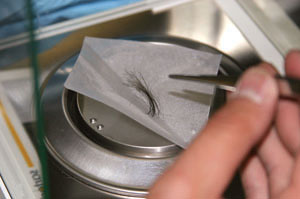Senior Reporter
OOIDA, CVTA Among Groups Voicing Opposition to Hair Testing for Drug Use

The written comments were in response to a federal drug advisory board’s request for information before it decides next month whether to recommend hair testing for federal employees with “safety sensitive” jobs.
The U.S. Department of Health and Human Services, which sets drug testing standards that are adopted by the Department of Transportation, currently allows urine-based drug testing and has proposed also allowing oral swab testing as an option.
The drug tests cover marijuana, cocaine, opiates, amphetamines and methamphetamines, and phencyclidine.
Testing is required for pre-employment, random, reasonable suspicion, certain post-accident, return to duty and follow-up.
Ronald Flegel, chairman of the nine-member advisory drug testing board of the Substance Abuse and Mental Health Services Administration, has said he believes the board will recommend a third option because it has “eliminated the obstacles to approving hair testing.”
The board has been studying hair testing for the past two years.
Some of the commenters don’t share Flegel’s position.
In written comments, the Owner-Operator Independent Drivers Association said that urine-based testing can more quickly detect recent drug use than hair testing, which can take from four to 10 days for the hair containing the drug to grow far enough from the scalp.
“The variances in hair types have also posed problems in standardizing drug testing,” OOIDA said. “Hair shape, size, formation, etc., varies by race, sex, age and position on the scalp, hair color and texture.”
“According to the American Civil Liberties Union, dark hair is more likely to test positive for a drug, and, additionally, African-Americans are more likely to test positive than Caucasians,” OOIDA added.
OOIDA called hair testing “a work in progress.”
“The ultimate measure of any change to the current methods for testing should be a reduction in crashes,” OOIDA said. “To this end, we encourage SAMHSA to evaluate the safety performance of companies which have voluntarily adopted hair testing.”
Hair testing also costs about $90 compared with $45 for urine-based testing, OOIDA said.
The Commercial Vehicle Training Association, a nonprofit association representing private truck driving schools, students and carriers, said its members are concerned that expanding drug testing options to include hair specimen testing “goes too far, and for no reason.”
“CVTA does not believe that adding hair specimen testing as an additional option would increase reliability or accuracy in testing more so than urine or oral swab testing,” the trade group said. “The expansion to hair specimen testing will simply be unnecessary once testing sites are able to conduct oral swab tests.”
The National School Transportation Association said the current science of hair testing is unreliable, with studies showing unacceptable levels of false positives due to environmental contamination.
“While there have been published claims that hair testing is accurate, they do not come from independent research subject to peer review,” the National Workrights Institute said. “Most such publications have come from parties with financial ties to the hair testing industry.”
In written comments in support of oral swab testing, American Trucking Associations said it also supports hair testing, which it said is well-suited to pre-employment drug testing.
“Hair testing, on average, gives employers a 90-day window of an applicant’s past drug use,” ATA said. “Additionally, hair testing benefits from observed collection by a trained professional and all prohibited drugs can be identified equally over the 90-day period.”
The advisory board has scheduled meetings for Aug. 6-7 to discuss the public comments — which will be accepted through July 29 — and finish deliberating the pros and cons of hair testing.
The board is then expected to take a vote via secret ballot on a final proposal that would be sent to SAMHSA Administrator Pamela Hyde.




